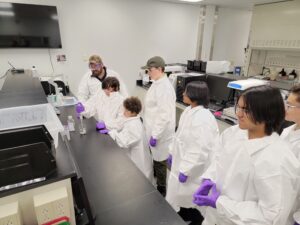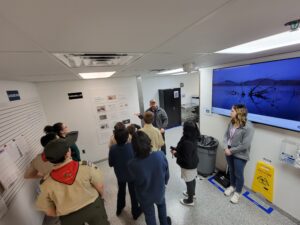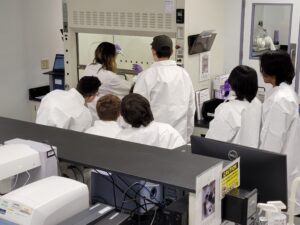 Scouts from Troop 1066 located in Jefferson, Maryland routinely pursue merit badges as a part of their Scouting Program. During the month of April, they chose to complete the Chemistry Merit Badge. During several meetings, Scouts learned the differences between physical and chemical changes, why atmospheric pressure can affect hikers and scuba divers, and why caramelization makes food taste delightful. Scouts also discovered why manufacturing single-use items can be harmful to the environment and why it’s important to safely store and dispose of products that could harm the environment. Scouts completed the Chemistry Merit Badge by visiting the biotech company, Lonza Walkersville, Inc located in Frederick County, Maryland.
Scouts from Troop 1066 located in Jefferson, Maryland routinely pursue merit badges as a part of their Scouting Program. During the month of April, they chose to complete the Chemistry Merit Badge. During several meetings, Scouts learned the differences between physical and chemical changes, why atmospheric pressure can affect hikers and scuba divers, and why caramelization makes food taste delightful. Scouts also discovered why manufacturing single-use items can be harmful to the environment and why it’s important to safely store and dispose of products that could harm the environment. Scouts completed the Chemistry Merit Badge by visiting the biotech company, Lonza Walkersville, Inc located in Frederick County, Maryland. The Walkersville location is the largest manufacturing site for Lonza Bioscience and has had a footprint in Frederick County since 1974. Scouts toured the facility and learned about a lifesaving product Lonza manufactures at the location. LAL, Limulus Amebocyte Lysate, is found in the blue blood of the Atlantic Horseshoe Crab and is a key component in Endotoxin Detection Kits. This incredibly unique compound is instrumental in detecting endotoxin found in Gram-negative bacteria. Endotoxin is widely present in the environment and exposure could lead to sepsis in humans.
The Walkersville location is the largest manufacturing site for Lonza Bioscience and has had a footprint in Frederick County since 1974. Scouts toured the facility and learned about a lifesaving product Lonza manufactures at the location. LAL, Limulus Amebocyte Lysate, is found in the blue blood of the Atlantic Horseshoe Crab and is a key component in Endotoxin Detection Kits. This incredibly unique compound is instrumental in detecting endotoxin found in Gram-negative bacteria. Endotoxin is widely present in the environment and exposure could lead to sepsis in humans. In order to ensure that Lonza creates the highest quality products, its Quality Control Laboratory uses chemistry to test raw materials arriving at the facility and finished products prior to shipping to customers. Scouts wore lab coats and safety glasses as they learned to weigh material, transfer liquids with a pipette, and watch a chemical reaction used to test reagents. The Scouts ended the Chemistry Merit Badge with newfound knowledge of the critical importance of a 475-million-year-old species and how the principles of chemistry can affect their everyday life.
In order to ensure that Lonza creates the highest quality products, its Quality Control Laboratory uses chemistry to test raw materials arriving at the facility and finished products prior to shipping to customers. Scouts wore lab coats and safety glasses as they learned to weigh material, transfer liquids with a pipette, and watch a chemical reaction used to test reagents. The Scouts ended the Chemistry Merit Badge with newfound knowledge of the critical importance of a 475-million-year-old species and how the principles of chemistry can affect their everyday life.

